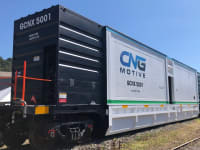The use of CNG as a fuel in locomotives offers the opportunity to reduce emissions such as particular matter (PM) in 97%, as well as a dramatic reduction in the cost of fuel and the consumption of a plentiful resources as is natural gas in the United States.
CNGmotive Inc. developed the technology to safely store >50x the typical CNG carried on a truck and the the filling technology Chillfill® that allows the tender to be filled in 10 minutes or less, similar to the speed of diesel.
The CNGmotive tenders are designed to transport compressed natural gas (CNG) for use in supplying energy alternate fuel locomotives to which it is coupled. Compressed natural gas is stored in impact and fire resistant pressure vessels that are secured and enclosed within an armored tender structure.
The CNGmotive fuel tender is designed to be in full compliance with the American Association of Railroads’ Specification M-1004, “SPECIFICATIONS FOR FUEL TENDERS”:
The tender general arrangement is such that the CNG pressure vessels (fuel tanks) are securely mounted to two rack structures centrally located within the carbody. The side walls of the tender in the area of the fuel tanks are equipped with energy absorbing crush panels to prevent the fuel tanks from being breached when being struck by the side impactor as specified in AAR Specification M-1004.
One end of the carbody is equipped with the gas conditioning system (CGS), also known as the pressure reduction skid (PRS), and the other end of the carbody is equipped with components necessary for tender control such as the tender control unit (TCU), air brake equipment, storage battery and charger and the remote reporting system.
The tender car body is designed to meet the load case and crash worthiness requirements defined in AAR Specification M-1004 and relevant paragraphs of AAR Specification M-1001.
One of the M-1004 requirements of crashworthiness and the most difficult to comply with is the Blunt sidewall impact : “No part of the fuel tank shall be punctured, split, crushed, or otherwise damaged so as to result in the release of fuel. The only acceptable fuel release allowed is that contained in piping external to the fuel tanks. All fuel tanks on the tender shall be capable of meeting this result.” The innovated design of the wall of the tender meets or exceeds all currently defined M-1004 standards, No-cylinder-leak standard met in all cases.
Additionally, the CNGmotive tender is equipped with locomotive style protection at each end which meet the derailment load cases as specified in AAR Standard S-5506.
Safety is the primary obstacle to carrying large quantities of fuel at the front of a train.
In a future zero emissions scenario, the same armored protection for railcars will be employed to carry hydrogen for locomotives as well as hydrogen containers for large scale industrial or utility scale users for power generation and heat.
CNGmotive will continue to advance the technology to enable cleaner alternative fuels for the railroad industry.
Like this entry?
-
About the Entrant
- Name:Pedro Santos
- Type of entry:teamTeam members:Pedro Santos
David Scott
Robert T. Scott
Graciela Trillanes
Suzette Doligale - Software used for this entry:Solidworks and CATIA
- Patent status:pending








